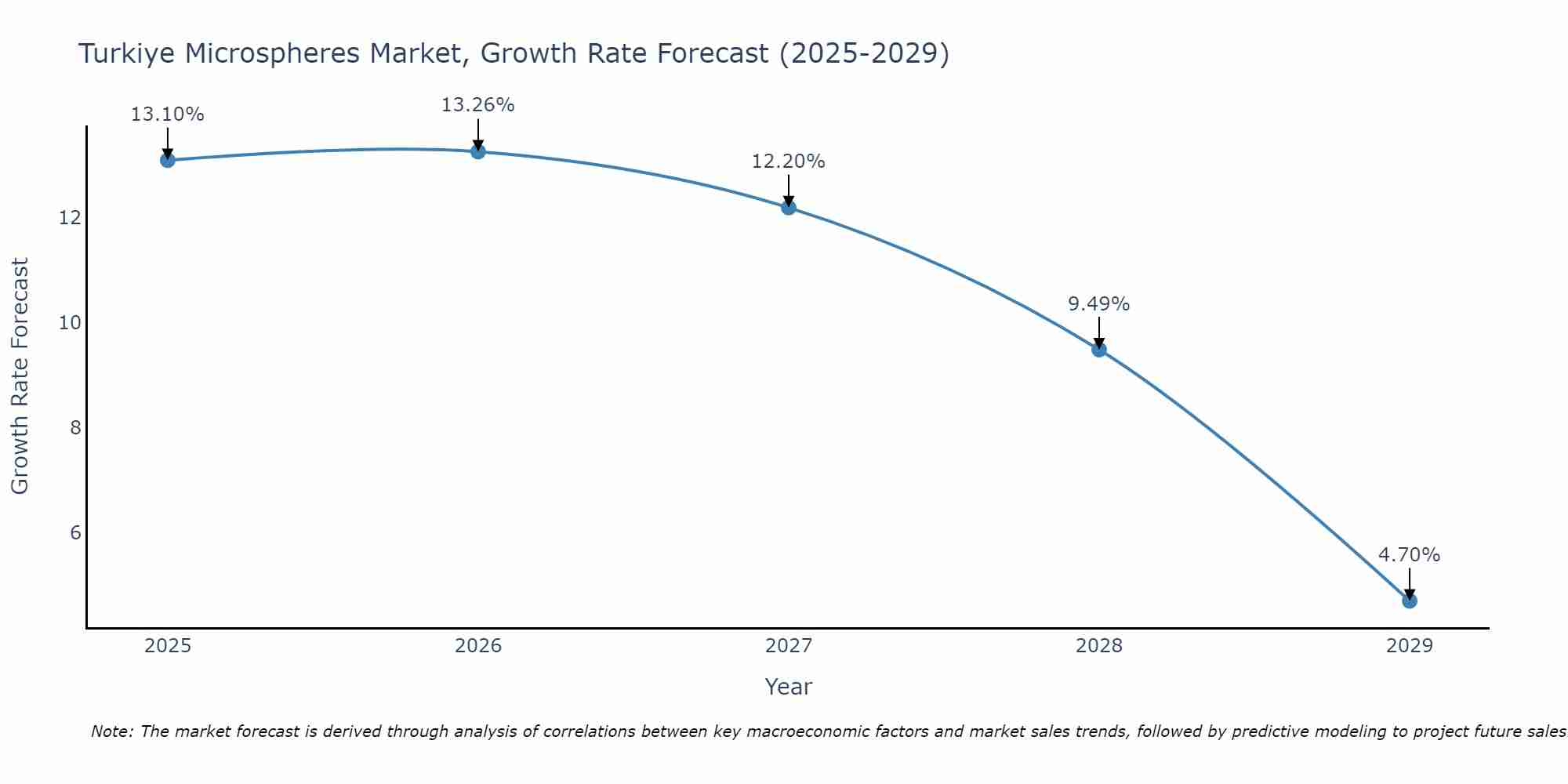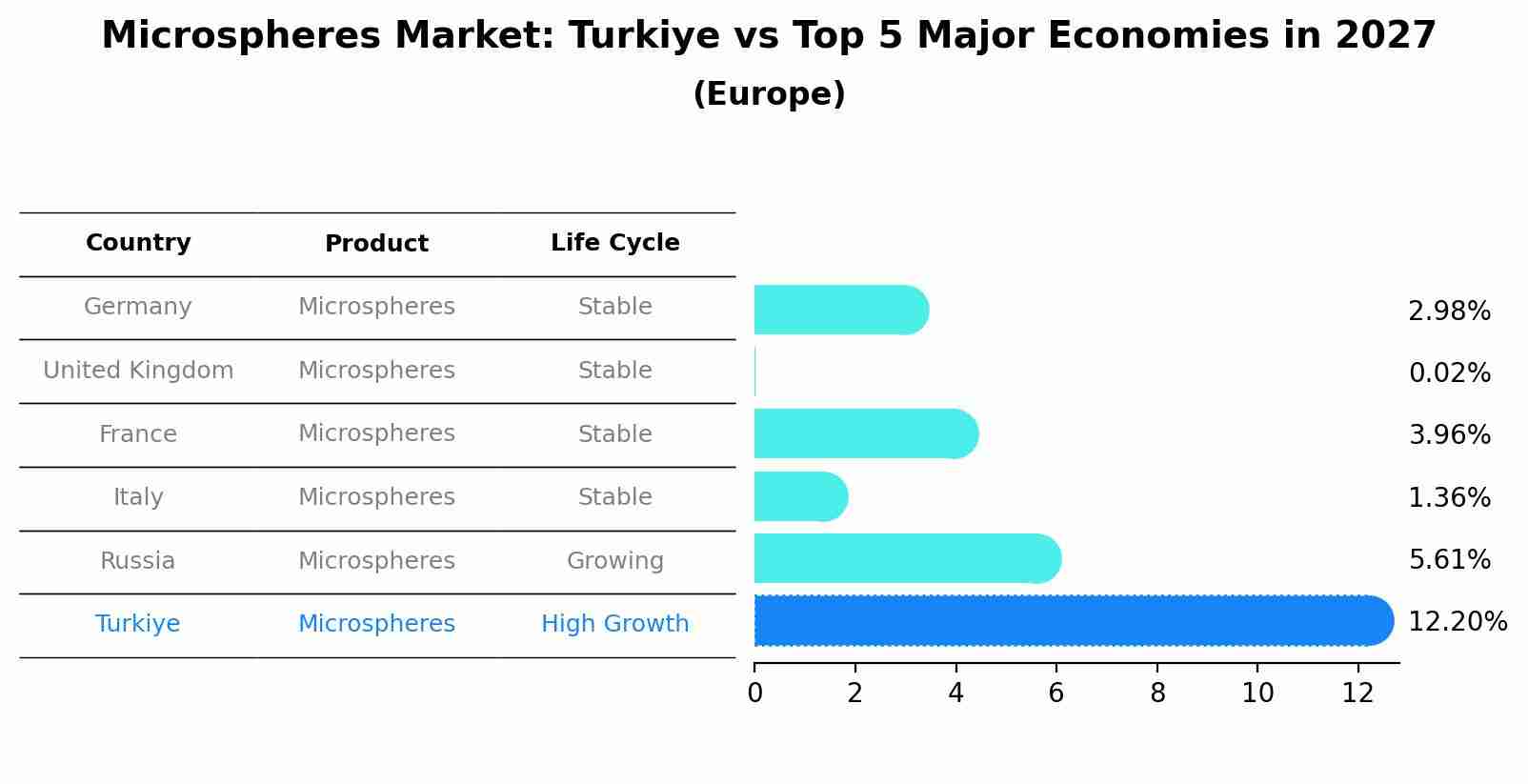Turkey Microspheres Market Outlook | Size, Revenue, Trends, COVID-19 IMPACT, Forecast, Analysis, Industry, Value, Growth, Companies & Share
| Product Code: ETC4497819 | Publication Date: Jul 2023 | Updated Date: Aug 2025 | Product Type: Report | |
| Publisher: 6Wresearch | Author: Dhaval Chaurasia | No. of Pages: 85 | No. of Figures: 45 | No. of Tables: 25 |
Turkiye Microspheres Market Size Growth Rate
The Turkiye Microspheres Market is projected to witness mixed growth rate patterns during 2025 to 2029. Starting at 13.10% in 2025, the market peaks at 13.26% in 2026, and settles at 4.70% by 2029.

Microspheres Market: Turkiye vs Top 5 Major Economies in 2027 (Europe)
The Microspheres market in Turkiye is projected to grow at a high growth rate of 12.20% by 2027, highlighting the country's increasing focus on advanced technologies within the Europe region, where Germany holds the dominant position, followed closely by United Kingdom, France, Italy and Russia, shaping overall regional demand.

Turkey Microspheres Market
The Turkey Microspheres Market is growing due to the rising use of microspheres in medical, pharmaceutical, and industrial applications. Microspheres offer unique properties such as controlled release, lightweight, and high surface area, enhancing product performance.
Drivers of the market
Turkey`s microspheres market is driven by applications in cosmetics, healthcare, construction materials, and automotive composites. Demand for lightweight fillers, additives, and functional materials offering enhanced performance characteristics drives market growth. Technological advancements in microsphere manufacturing techniques and material innovations support market competitiveness.
Challenges of the market
The microspheres market in Turkey encounters challenges such as developing uniform particle size distribution for precise applications in healthcare and industrial sectors, ensuring biocompatibility in medical uses, and complying with safety standards in microsphere manufacturing.
Government Policy of the market
In Turkey, government policies promote the microspheres market through investments in pharmaceuticals, cosmetics, and industrial applications. Regulatory frameworks ensure product safety and quality standards, supporting innovation in drug delivery systems and specialty materials.
Key Highlights of the Report:
- Turkey Microspheres Market Outlook
- Market Size of Turkey Microspheres Market, 2022
- Forecast of Turkey Microspheres Market, 2031
- Historical Data and Forecast of Turkey Microspheres Revenues & Volume for the Period 2021-2031
- Turkey Microspheres Market Trend Evolution
- Turkey Microspheres Market Drivers and Challenges
- Turkey Microspheres Price Trends
- Turkey Microspheres Porter's Five Forces
- Turkey Microspheres Industry Life Cycle
- Historical Data and Forecast of Turkey Microspheres Market Revenues & Volume By Type for the Period 2021-2031
- Historical Data and Forecast of Turkey Microspheres Market Revenues & Volume By Hollow for the Period 2021-2031
- Historical Data and Forecast of Turkey Microspheres Market Revenues & Volume By Solid for the Period 2021-2031
- Historical Data and Forecast of Turkey Microspheres Market Revenues & Volume By Raw Material for the Period 2021-2031
- Historical Data and Forecast of Turkey Microspheres Market Revenues & Volume By Glass for the Period 2021-2031
- Historical Data and Forecast of Turkey Microspheres Market Revenues & Volume By Ceramic for the Period 2021-2031
- Historical Data and Forecast of Turkey Microspheres Market Revenues & Volume By Fly Ash for the Period 2021-2031
- Historical Data and Forecast of Turkey Microspheres Market Revenues & Volume By Polymer for the Period 2021-2031
- Historical Data and Forecast of Turkey Microspheres Market Revenues & Volume By Metallic for the Period 2021-2031
- Historical Data and Forecast of Turkey Microspheres Market Revenues & Volume By Application for the Period 2021-2031
- Historical Data and Forecast of Turkey Microspheres Market Revenues & Volume By Construction Composites for the Period 2021-2031
- Historical Data and Forecast of Turkey Microspheres Market Revenues & Volume By Medical Technology for the Period 2021-2031
- Historical Data and Forecast of Turkey Microspheres Market Revenues & Volume By Cosmetics & Personal Care for the Period 2021-2031
- Historical Data and Forecast of Turkey Microspheres Market Revenues & Volume By Automotive for the Period 2021-2031
- Historical Data and Forecast of Turkey Microspheres Market Revenues & Volume By Oil & Gas for the Period 2021-2031
- Turkey Microspheres Import Export Trade Statistics
- Market Opportunity Assessment By Type
- Market Opportunity Assessment By Raw Material
- Market Opportunity Assessment By Application
- Turkey Microspheres Top Companies Market Share
- Turkey Microspheres Competitive Benchmarking By Technical and Operational Parameters
- Turkey Microspheres Company Profiles
- Turkey Microspheres Key Strategic Recommendations
Frequently Asked Questions About the Market Study (FAQs):
1 Executive Summary |
2 Introduction |
2.1 Key Highlights of the Report |
2.2 Report Description |
2.3 Market Scope & Segmentation |
2.4 Research Methodology |
2.5 Assumptions |
3 Turkey Microspheres Market Overview |
3.1 Turkey Country Macro Economic Indicators |
3.2 Turkey Microspheres Market Revenues & Volume, 2022 & 2031F |
3.3 Turkey Microspheres Market - Industry Life Cycle |
3.4 Turkey Microspheres Market - Porter's Five Forces |
3.5 Turkey Microspheres Market Revenues & Volume Share, By Type, 2022 & 2031F |
3.6 Turkey Microspheres Market Revenues & Volume Share, By Raw Material, 2022 & 2031F |
3.7 Turkey Microspheres Market Revenues & Volume Share, By Application, 2022 & 2031F |
4 Turkey Microspheres Market Dynamics |
4.1 Impact Analysis |
4.2 Market Drivers |
4.2.1 Increasing demand for lightweight materials in various industries such as construction, automotive, and healthcare |
4.2.2 Growing usage of microspheres in cosmetics and personal care products for enhancing texture and appearance |
4.2.3 Rising focus on sustainable and eco-friendly products driving the adoption of bio-based microspheres |
4.3 Market Restraints |
4.3.1 High production costs associated with manufacturing microspheres may limit market growth |
4.3.2 Stringent regulations regarding the use of certain types of microspheres in specific applications |
4.3.3 Limited availability of raw materials required for producing specialized microspheres |
5 Turkey Microspheres Market Trends |
6 Turkey Microspheres Market, By Types |
6.1 Turkey Microspheres Market, By Type |
6.1.1 Overview and Analysis |
6.1.2 Turkey Microspheres Market Revenues & Volume, By Type, 2021-2031F |
6.1.3 Turkey Microspheres Market Revenues & Volume, By Hollow, 2021-2031F |
6.1.4 Turkey Microspheres Market Revenues & Volume, By Solid, 2021-2031F |
6.2 Turkey Microspheres Market, By Raw Material |
6.2.1 Overview and Analysis |
6.2.2 Turkey Microspheres Market Revenues & Volume, By Glass, 2021-2031F |
6.2.3 Turkey Microspheres Market Revenues & Volume, By Ceramic, 2021-2031F |
6.2.4 Turkey Microspheres Market Revenues & Volume, By Fly Ash, 2021-2031F |
6.2.5 Turkey Microspheres Market Revenues & Volume, By Polymer, 2021-2031F |
6.2.6 Turkey Microspheres Market Revenues & Volume, By Metallic, 2021-2031F |
6.3 Turkey Microspheres Market, By Application |
6.3.1 Overview and Analysis |
6.3.2 Turkey Microspheres Market Revenues & Volume, By Construction Composites, 2021-2031F |
6.3.3 Turkey Microspheres Market Revenues & Volume, By Medical Technology, 2021-2031F |
6.3.4 Turkey Microspheres Market Revenues & Volume, By Cosmetics & Personal Care, 2021-2031F |
6.3.5 Turkey Microspheres Market Revenues & Volume, By Automotive, 2021-2031F |
6.3.6 Turkey Microspheres Market Revenues & Volume, By Oil & Gas, 2021-2031F |
7 Turkey Microspheres Market Import-Export Trade Statistics |
7.1 Turkey Microspheres Market Export to Major Countries |
7.2 Turkey Microspheres Market Imports from Major Countries |
8 Turkey Microspheres Market Key Performance Indicators |
8.1 Research and development investment in innovative microsphere technologies |
8.2 Adoption rate of microspheres in emerging applications and industries |
8.3 Number of partnerships and collaborations for expanding market reach and product offerings |
9 Turkey Microspheres Market - Opportunity Assessment |
9.1 Turkey Microspheres Market Opportunity Assessment, By Type, 2022 & 2031F |
9.2 Turkey Microspheres Market Opportunity Assessment, By Raw Material, 2022 & 2031F |
9.3 Turkey Microspheres Market Opportunity Assessment, By Application, 2022 & 2031F |
10 Turkey Microspheres Market - Competitive Landscape |
10.1 Turkey Microspheres Market Revenue Share, By Companies, 2022 |
10.2 Turkey Microspheres Market Competitive Benchmarking, By Operating and Technical Parameters |
11 Company Profiles |
12 Recommendations |
13 Disclaimer |
- Single User License$ 1,995
- Department License$ 2,400
- Site License$ 3,120
- Global License$ 3,795
Search
Thought Leadership and Analyst Meet
Our Clients
Related Reports
- Canada Oil and Gas Market (2026-2032) | Share, Segmentation, Value, Industry, Trends, Forecast, Analysis, Size & Revenue, Growth, Competitive Landscape, Outlook, Companies
- Germany Breakfast Food Market (2026-2032) | Industry, Share, Growth, Size, Companies, Value, Analysis, Revenue, Trends, Forecast & Outlook
- Australia Briquette Market (2025-2031) | Growth, Size, Revenue, Forecast, Analysis, Trends, Value, Share, Industry & Companies
- Vietnam System Integrator Market (2025-2031) | Size, Companies, Analysis, Industry, Value, Forecast, Growth, Trends, Revenue & Share
- ASEAN and Thailand Brain Health Supplements Market (2025-2031) | Strategy, Consumer Insights, Analysis, Investment Trends, Opportunities, Growth, Size, Share, Industry, Revenue, Segments, Value, Segmentation, Supply, Forecast, Restraints, Outlook, Competition, Drivers, Trends, Demand, Pricing Analysis, Competitive, Strategic Insights, Companies, Challenges
- ASEAN Bearings Market (2025-2031) | Strategy, Consumer Insights, Analysis, Investment Trends, Opportunities, Growth, Size, Share, Industry, Revenue, Segments, Value, Segmentation, Supply, Forecast, Restraints, Outlook, Competition, Drivers, Trends, Demand, Pricing Analysis, Competitive, Strategic Insights, Companies, Challenges
- Europe Flooring Market (2025-2031) | Outlook, Share, Industry, Trends, Forecast, Companies, Revenue, Size, Analysis, Growth & Value
- Saudi Arabia Manlift Market (2025-2031) | Outlook, Size, Growth, Trends, Companies, Industry, Revenue, Value, Share, Forecast & Analysis
- Uganda Excavator, Crane, and Wheel Loaders Market (2025-2031) | Strategy, Consumer Insights, Analysis, Investment Trends, Opportunities, Growth, Size, Share, Industry, Revenue, Segments, Value, Segmentation, Supply, Forecast, Restraints, Outlook, Competition, Drivers, Trends, Demand, Pricing Analysis, Competitive, Strategic Insights, Companies, Challenges
- Rwanda Excavator, Crane, and Wheel Loaders Market (2025-2031) | Strategy, Consumer Insights, Analysis, Investment Trends, Opportunities, Growth, Size, Share, Industry, Revenue, Segments, Value, Segmentation, Supply, Forecast, Restraints, Outlook, Competition, Drivers, Trends, Demand, Pricing Analysis, Competitive, Strategic Insights, Companies, Challenges
Industry Events and Analyst Meet
Whitepaper
- Middle East & Africa Commercial Security Market Click here to view more.
- Middle East & Africa Fire Safety Systems & Equipment Market Click here to view more.
- GCC Drone Market Click here to view more.
- Middle East Lighting Fixture Market Click here to view more.
- GCC Physical & Perimeter Security Market Click here to view more.
6WResearch In News
- Doha a strategic location for EV manufacturing hub: IPA Qatar
- Demand for luxury TVs surging in the GCC, says Samsung
- Empowering Growth: The Thriving Journey of Bangladesh’s Cable Industry
- Demand for luxury TVs surging in the GCC, says Samsung
- Video call with a traditional healer? Once unthinkable, it’s now common in South Africa
- Intelligent Buildings To Smooth GCC’s Path To Net Zero


















